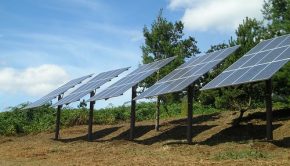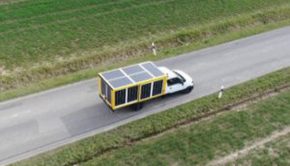Safe Harbor in the Covid storm for your 2020 solar project: “Do it now.” –
Safe Harbor in the Covid storm for your 2020 solar project: “Do it now.” –
What is different this year from last year when thinking about filing a Solar Safe Harbor extension for 2020 ITC?
Before we turn to the answer, please note that this article is an update to my April 2019 article called Understanding Safe Harbor for Extending ITC. I suggest reading it first as a background to the concepts discussed below, as I assume familiarity with those fundamentals here.
The safety zones of Safe Harbor are rolling back and forth, think barrels across the deck of a yawing ship. Just when you adjusted to 2020’s exceptions, here comes 2021, and it’s not going in the same direction…if everything stays the same. And what’s the chance of that?
To make sense of this rolling uncertainty, I called upon John Marciano, one of the go-to tealeaf readers in the small world of solar tax equity. John is a partner at Akin Gump Straus Hauer and Feld LLP; he is also the Chair of the Tax Committee with the Solar Energy Industry Association.
2020 Congressional Action on the Covid Extension
To understand what we are coming into, says John Marciano, you have to understand what occurred this past year, legislatively. The IRS offers two scenarios to allow Safe Harbor claims: “money or sweat”. The traditional residential or commercial rooftop financing strategy of choice has been “money”, or a 5% spend on the project cost, during the effective year, with a delivery requirement within three-and-a-half months of the effective spend date.
This past Winter (2019/2020), folks that had placed their Safe Harbor deposits begun having all sorts of concerns about the impact of the epidemic on their ability to comply. In fact, says Marciano, “there was no reason to panic about it, because the language reads specifically that you must ‘reasonably expect’ delivery within the three-and-a-half months period. Obviously, our crowned virus could not be anticipated; but few people read between the lines of that language.” To assuage fears and minimize project impact, Congress provided clarity in March of this year by saying that the period of delivery could be extended to September, a generous delay in the delivery obligation, and leaving intact the 48-month leeway to complete the project.
Last year’s “reasonable expectation” is not this year’s.
Let’s say a project is under current consideration but has multiple design options, for example, perhaps several site options, and the final location of the power plant remains fluid. In this case, component purchase is the safe vesting procedure to anchor the 2020 ITC into the project financials. Marciano reminds us that soft costs, such as engineering and design, are not considered an allowable expense for Safe Harbor consideration. So you have to order and pay for goods intended for the project.
But now you know all about Covid, the way it renders the future opaque. You cannot
“reasonably expect” that there will be no Covid-related issues in Winter 2021. So, explains John Marciano, if you spend 5% on or before December 31 expecting to take delivery of those goods in time, but a new Corona wave disrupts manufacturing and distribution pipeline and you get your goods on April 25, well…that’s on you. Under current guidelines, you do not qualify for Safe Harbor. Your project’s ITC rate is not 26%, but 22%. Might another congressional letter come out to provide extension? That’s uncertain, particularly in a presidential election-year, so best to assume “no.”
For that reason, rooftop solar construction projects opting for the “money” approach should be clear in their current discussions with their suppliers and distributors about the need for delivery within the required three-and-a-half-month timeline, and what the last delay is to guarantee that without fail.
Of course, we can also use the “sweat” method, which might be more within your control.
For example, those projects requiring long trench runs and that have started before year’s end will qualify under the “work” requirement the IRS stipulates; this might be true of solar carport installations, for example. But refer to last year’s article for the additional burdens of using the work method. In many ways they are much more stringent than the “money” method because of the “continuous” expectation, also subject to derailment due to Covid19 ugliness.
John shares the acronym “FAD” as a way to help you remember how you can meet the “work” or sweat expectation in the IRS guidelines.
- F is for fabricate, like asking a supplier to build a custom product integral to the specifics of that particular project, “Custom inverters technically should work, but less accepted than transformers”, says John, inferring that tax equity is not as comfortable with this.
- A is for assemble, “actually building the project on site. You have 50% of the project installed, for example.”
- D is for dig, like trenching for solar carport conduit runs. “Dig is harder for solar since there isn’t a lot to dig. Most people think installing roughly 30% of the footings on which racking sits is sufficient for a solar project. We don’t see a lot of that yet though.” (read: that has not been tested with the IRS, so tax equity remains conservative about it)
“Do it now.”
John Marciano does not mince words in his advice to anyone looking to Safe Harbor this year. There is a lot of uncertainty, and the scheduled drop in ITC this year is from 26% to 22%. That’s a 4% increase in project cost to the investor or a 15.5% drop in the value of the US Federal rebate. In terms of actual costs (assuming a blended installed cost of $2.50/W for C&I solar projects including carport etc.), that’s 10 cents per installed watt in additional project cost to the investor. In a tight cashflow projection, this might make a real difference between a project being greenlighted or not. If it is assumed, then losing it as a result of a Safe Harbor technicality could be bad news.
“Supply questionability is the problem,” says Marciano. This does not mean doom and gloom for those who wait until December 31st to make their component orders of course. Legal counsel on the subject wants to establish bases as close to certainty as possible, because that’s what you pay them to do for you. So if you want to be feeling good about your Safe Harbor compliance when you put on your pointy hat and confetti colored face mask on New Year’s eve 20/21, you follow counsel’s advice and get your component orders in now for at least 5% of the contract value; there’s no telling how reliable or predictable supplies will be like next Winter.
What might happen to ITC
Given John Marciano’s bow view of the legislative dialog on solar tax policy, I thought it would be useful to share his perspective on where things might go.
There is clamor to extend the ITC. Mayors, industry leaders and even bi-partisan congressional efforts have requested urgent action on the matter. What will happen, says John Marciano, depends on multiple scenarios.
- If there is a new administration with a supportive Congress (read: if the Senate flips), then there will “almost certainly be an extension” or, given that we will be at the 22% ITC rate at that time, a new law that would re-establish a 30% ITC for a given amount of time.
- If there is not a supportive Congress, then the future becomes murkier. However, says John, “there is a bi-partisan ask for ‘storage as a stand-alone’ ITC, probably because storage is technology agnostic and works with coal as well as natural gas.”
- If the current administration remains, John would not venture a guess.
The Take-Away
The Covid extension of the 2020 Safe Harbor is not relevant to the 2021 Safe Harbor period. While there are a lot of possibilities for the solar and/or storage ITC looking beyond 2020, the only reality is what we know now: the ITC is dropping and all pre-2020 Safe Harbor rules apply. Given the uncertainty beyond that, there is a rush to close projects; supply constraints are likely and, in the worst case, we will have complete Covid-related interruptions in supply. So the advice to contractors and developers is : get your contracts locked-in immediately, because available tax equity may not be willing to take risks come Fall.









